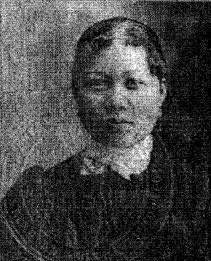In 1899, Ah Sou, a Chinese orphan, was sold to a man named Moy Sam with the belief that she would accompany him to the United States of America to become his daughter. There are no records indicating why or how she was sold. After her trip across the Pacific Ocean, she landed at Port Townsend, Washington, on August 23, 1900, and discovered that she would be forced into prostitution.1 Despite learning this, she followed the orders she was given, and told immigration inspectors at the entry port that Moy Sam was her father and a merchant.

After enduring three years of abuse from Moy Sam, she overheard that she was about to be sold to another man for further exploitation. She decided that she needed to act fast before being sold, and found a way to escape in November of 1903 to The Home for Chinese Women and Girls. Reverend William Holt and his wife, Frances Holt, unintentionally founded the home in Portland, Oregon after serving as American missionaries in China. It began with one Chinese woman who sought refuge with Reverend and Mrs. Holt; not long after, more women followed her lead. Eventually, the home, located at 350 Fourteenth Street, was opened in April 1889.2
There was a Board of Directors of the Home in Portland, which gave it a certain degree of legitimacy. The home taught the women how to speak English, as well as how to read English and Chinese. They were educated in various skills, such as housework, needle-work, and Bible studies. Mrs. Holt said, “They eat Chinese food, wear Chinese clothes, except the shoes, have very plain furniture in their rooms, and are led to look forward to such lives as respectable, intelligent Chinese women may hope to enjoy. The purpose is not to make them over into American women, which might end in dissatisfaction and unhappiness by and by, but we want them to develop into good, useful Chinese women.”3 The home was such a success that a deaf-mute girl, who was raised there, gave a speech at a board meeting, gesturing, “More love to thee.”4

While Ah Sou was at the home, she was the only girl there, which made the days long and boring for her. While she was there, she was married by Reverend Holt to a Chinese man named Lum Kong, because they believed that he was a Chinese merchant. That was important, because being married to a Chinese merchant meant that Ah Sou would be able to legally stay in America. After a number of weeks, Ah Sou made it very clear that she wanted to leave the home, because being the only girl there made her feel very lonely. Frances Holt and the staff did not like the idea of her leaving. Mrs. Holt said, “We wished [Ah Sou] to stay, we did everything we could to persuade her to stay, we hoped she would stay with us for a year or more and it was [Lum Kong’s] wish that she stay, but she said she did not want to, she preferred to leave.”5 Although Lum Kong wanted Ah Sou to stay, he did nothing to keep her from leaving because their marriage did not mean much to him. He knew that the sole reason for their marriage was to try to legalize her status in the United States.
After she left the home, Ah Sou traveled to Seattle where she ran into Moy Sam, who was cooperating with law enforcement to have her arrested. On January 1, 1904, she was arrested by an immigration inspector, and on January 8, 1904, Commissioner James Kiefer ordered her to be deported to China. In between her apprehension and the deportation order, there was a lengthy hearing at which a number of witnesses testified. These witnesses included: the immigration inspectors who arrested and interviewed Ah Sou, a baggageman for the Northern Pacific Railroad who knew Moy Sam, the photographer who helped Moy Sam create a fake family photograph, Mrs. Holt, the employer of Lum Kong, and Lum Kong. When Ah Sou was asked about her time with Moy Sam she said, “I was whipped and beaten by [Moy Sam]. Every day I was beaten by him with sticks of wood until I was black and blue.”6 She also informed the court that she never received any of her earnings during her time with Moy Sam. At the end of the hearing, it was decided that the only reason for Ah Sou’s marriage was so that she would not be deported, thus making her deportable. She was seen as nothing more than an illegal immigrant turned prostitute. However, Ah Sou refused to give up and appealed the deportation order to the United States District Court for the District of Washington, where Judge Cornelius Hanford presided over her appeal.

Although Judge Hanford’s further investigation led him to find out that Lum Kong was not actually a merchant, and he agreed that Ah Sou’s marriage was not bona fide, he still decided to reverse the deportation order. Judge Hanford stated, “The laws excluding Chinese immigrants and women imported for immoral purposes require the court to cause a person in the situation of the appellant to be deported to China. Compliance with the statute in this case will be, in my estimation, a barbarous proceeding, for it will be equivalent to remanding the appellant to perpetual slavery and degradation.”7 He also emphasized Ah Sou’s great effort to escape Moy Sam and create a life for herself. He stressed that the Thirteenth Amendment prohibits slavery and that the only way she could be emancipated was if she was released from custody and allowed to remain in America. Unfortunately, the government appealed Judge Hanford’s decision to the United States Court of Appeals for the Ninth Circuit.
Ah Sou argued that the court did not have any right to her case, and said, “[The] sole question involved is the application of the thirteenth amendment to the Constitution of the United States, and that therefore the appellate jurisdiction of the Supreme Court is exclusive.” However, the Judiciary Act of 1891 gave the Supreme Court exclusive jurisdiction over “the construction or application of the Constitution of the United States.”8 This court ruled, “We see no escape from the conclusion that the judgment of the trial court must be reversed, and the appellee remanded to the country whence she came.”9 Ah Sou tried appealing this ruling to the Supreme Court, but her appeal was denied for lack of jurisdiction. On March 8, 1906 Ah Sou was placed aboard a steamer named “Manchuria,” and left San Francisco for Hong Kong, China. That is where her records end; nothing more was heard of Ah Sou.10
Unfortunately, there are many other stories just like Ah Sou’s, where young girls are sexually exploited and are seen as nothing more than illegal immigrants. More recently, the Trafficking Victims Protection Act of 2000 has been created to help persons trafficked and ensure that traffickers face adequate consequences. This act ensures that governments have recovery centers that provide medical treatments to heal the physical and mental abuse that victims endure. Yet there are still instances like Ah Sou’s that have holes and gaps in their journey that may never be discovered, as sex-trafficking victims are only provided minimal care so that some governments can say that they are doing their job to make sure the victims are accounted for.11
It is not shocking that a Chinese orphan was so easily tricked into being trafficked. Sex trafficking is still a global issue, but is especially prevalent in China. During China’s early years of economic liberalization, sex establishments were operated in the Special Economic Zones. These establishments catered to everyone–clients ranged from local businessmen to foreign investors. The sex-trafficking industry is so common in China, that every major city has a red-light district, which is where sex establishments congregate to make it easier for people to locate them.12 If you or anyone you know is being sex-trafficked or at risk, the National Human Trafficking Hotline is +1 (888) 373-7888. They have translators that speak over 200 language who are available 24/7. If you would like to send them a message, text “HELP” or “INFO” to 233733. For more information please visit https://humantraffickinghotline.org/.13
- Margaret McKeown and Emily Ryo, “The Lost Sanctuary: Examining Sex Trafficking Through the Lens of United States v. Ah Sou,” Cornell International Law Journal 41, no. 3 (2008): 748. ↵
- Margaret McKeown and Emily Ryo, “The Lost Sanctuary: Examining Sex Trafficking Through the Lens of United States v. Ah Sou,” Cornell International Law Journal 41, no. 3 (2008): 749. ↵
- Margaret McKeown and Emily Ryo, “The Lost Sanctuary: Examining Sex Trafficking Through the Lens of United States v. Ah Sou,” Cornell International Law Journal 41, no. 3 (2008): 750. ↵
- David Livingstone, “What Japanese Christian Women are Doing for Korea,” Woman’s Work 48, no. 3 (1913): 165. ↵
- Margaret McKeown and Emily Ryo, “The Lost Sanctuary: Examining Sex Trafficking Through the Lens of United States v. Ah Sou,” Cornell International Law Journal 41, no. 3 (2008): 751. ↵
- Margaret McKeown and Emily Ryo, “The Lost Sanctuary: Examining Sex Trafficking Through the Lens of United States v. Ah Sou,” Cornell International Law Journal 41, no. 3 (2008): 749. ↵
- Margaret McKeown and Emily Ryo, “The Lost Sanctuary: Examining Sex Trafficking Through the Lens of United States v. Ah Sou,” Cornell International Law Journal 41, no. 3 (2008): 753. ↵
- Margaret McKeown and Emily Ryo, “The Lost Sanctuary: Examining Sex Trafficking Through the Lens of United States v. Ah Sou,” Cornell International Law Journal 41, no. 3 (2008): 754-755. ↵
- Margaret McKeown and Emily Ryo, “The Lost Sanctuary: Examining Sex Trafficking Through the Lens of United States v. Ah Sou,” Cornell International Law Journal 41, no. 3 (2008): 755. ↵
- Margaret McKeown and Emily Ryo, “The Lost Sanctuary: Examining Sex Trafficking Through the Lens of United States v. Ah Sou,” Cornell International Law Journal 41, no. 3 (2008): 755. ↵
- “2018 Trafficking in Persons Report” (Department of State, June 2018), 4,39 https://www.state.gov/documents/organization/282798.pdf. ↵
- Bonny Ling, “Human Trafficking and China: Past and Present” (Thesis, National University of Ireland Galway, 2014), http://hdl.handle.net/10379/4730. ↵
- “National Human Trafficking Hotline,” National Human Trafficking Hotline, accessed April 6, 2019, https://humantraffickinghotline.org/node. ↵



55 comments
Mohammed Hani Shaik
Great Article! This incident shows some of the major flaws in the system that allowed for the exploitation of so many people. We may think that this is a story of the past and that things have gotten better but reality is that we are in no way a better state than the 1900’s and in fact might be even worse off. I say this based off the exploitation of the uighur muslims in China.
Trenton Boudreaux
A tragic fact of life for immigrants in the Gilded Age. A fascinating if not depressing read, it is fascinating how Ah Sou was so determined to remain in the US. Although, given the situation in China, it is not surprising. I wish that one day we can find more records for what happened to Ah Sou after being sent back to China, but I fear that day may never come.
Madeline Chandler
Such an informative and interesting article! Very captivating. Honestly I am unfamiliar with the story of Ah Sou, like many others. However I am always fascinated by how she stood up for her human rights. I honestly do not have much knowledge on stories like this, but do think the United States has the ability to create a difference for people from similar situations. This was such a transition for people and countries regarding immigration and deportation statue. I loved reading your article. Great job.
Shriji Lalji
I am shocked at how easily someone can just go get an orphan from china and exploit the orphan for anything. It is disappointing that we have universal human rights but they are not honored in many cases. I applaud Ah Sou for fighting her cases and appealing them. However I would have liked to see the courts stand up for her in the end. Despite trafficking continuing to have a significant impact on many lives, there has been little change.
Aleea Costilla
Great article! This is a tragic story of how the system failed to protect an immigrant that was exploited and in turn deported for her status. But the awareness that was given to show this is still an issue in the world, especially in China, is much needed to understand how the United States can improve the circumstances for those alike Ah Sou. Unfortunately, she never had a successful story because the laws at the time did not accommodate to her situation.
Eric Grant
I can only imagine how Ah Sou felt throughout her journey here, only to be deported in the end. A lot of people forget the xenophobic sentiments felt towards Chinese immigrants for example by the Chinese Exclusionary Act of 1882. The saddest part in my opinion is how this is still common in many parts around the country today. Ah Sou’s story is eye-opening and sheds light on the ineptitude of the United States to deal with sex-trafficking.
Yamel Herrera
This was a great article. It’s saddening to read that Ah Sou’s known story ends with her journey to Hong Kong, China via a steamer. I think the fact that her story does not have a “happy ending” allows the article to further emphasizes the reality of human trafficking victims. If it is difficult for U.S. citizens who are victims of human trafficking to get justice, it is even more difficult for immigrants to be granted the same protections. Although we do not know more of her story, it is admirable to know that Ah Sou was courageous enough to speak up for herself when no one else would.
Genesis Vera
It is saddening to hear that her story ends after she gets on the Steamer but at least some of her story is now being told. This is a great example of how our justice system is not in accordance with the real world. The fact that the Trafficking Victims Protection Act was put into place in 2000 only showcases how behind our justice system is. I’m glad some attention was brought to this topic because I think it is one that many people feel uncomfortable talking about. Overall, the article presented an intriguing story.
Allison Grijalva
This is a great article! I agree with some of the previous comments that it was a powerful choice to choose the story of someone who did not have a “happy ending.” It is extremely sad and scary to think about all of the women who have similar stories, and even experience this still today. The court’s ruling did not come as a surprise however. She was an immigrant, and it just goes to show how the U.S. tends to rule against immigrants despite circumstances.
Kayla Mendez
Although there are stories of women surviving the effects of being sex trafficked, I appreciate the author’s decision to choose a story without a “happy ending”. We can only hope that Ah Sou took what she learned from The Home for Chinese Women and Girls and used it to make a stable life for herself. To endure such a thing, and still face the man that hurt her took strength hat I don’t even think I have. The prevalence of sex trafficking today brings even more importance to this story, for these situations didn’t just occur in the past, they are occurring today in countries all over the world.